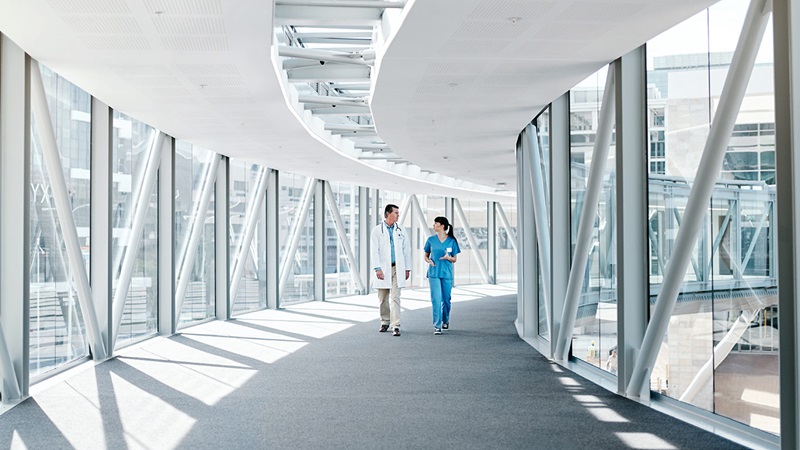Delivering net zero healthcare estates
World economies are increasingly creating policies to directly tackle the climate crisis, with governments striving to reach net zero by 2050. During COP28, Buildings Breakthrough set global aspirations to make ‘near-net-zero and resilient buildings the new normal’ by 2030, and this pledge was signed by 20 countries, including the UK. These are ambitious, yet essential targets. However, sectors that suffer from aging infrastructure, like healthcare, face an uphill battle in aligning with these goals.
With an ability to impose legislation and provide financial incentives, it is no wonder that government bodies are often deemed accountable for progressing climate change and decarbonisation. In Mace’s recent Carbon Survey, 36% of respondents believed that the onus should be placed on the government for the carbon footprint of a building. However, the built environment sector is also a key player on the road to creating greener healthcare estates.
There’s a shared responsibility among healthcare providers and construction professionals to make these ambitions a reality. Darren Calderwood, Business Unit Director, shares his thoughts on the challenges we face to achieve these targets and how sharing knowledge will be crucial in establishing widespread best practice.
Committing to building a greener future
The healthcare industry is said to contribute 4-5% of global emissions, more than aviation and shipping combined. If we look at the UK as an example, many hospitals were built across the 20th century, meaning the National Health Service (NHS) is now dealing with outdated estates, with buildings that do not stack up against modern efficiency measures. Healthcare providers risk heavy sanctions, high utility bills, or the real possibility of losing their assets altogether. With the NHS said to be responsible for 4% of Britain’s carbon emissions, tackling this issue is essential in the nation’s route to net zero.
The good news is that this problem will be addressed, in part, by the UK government’s New Hospital Programme (NHP), a pledge to upgrade upwards of 30 hospitals by 2030, including repairing those where reinforced autoclaved aerated concrete (RAAC) has been found. The £20 billion scheme is said to prioritise aging estates, which pose a risk to both staff and patients and significantly reduce energy inefficiencies in existing hospitals.
Schemes like NHP will create a legacy for clinicians and patients around the world, improving existing facilities and shoring up respective government responses to net zero. The challenge, however, will be in how those delivering the programme best collaborate and share this knowledge with partners and peers to further cut emissions across the sector.
Transferring industry knowledge
Arguably, while all healthcare providers recognise the need for their estates to reach net zero emissions, some are more nuanced in their approach than others. It is essential that healthcare leaders share their experiences to drive best practice around the world.
In a similar exercise to the UK, Hong Kong has mapped out a 10-year healthcare development plan, which focuses on improving care and creating new hospital sites. With both countries suffering from aging estates, they are committed to delivering healthcare facilities fit for the future, and this includes planning with low carbon construction and operations in mind.
It is therefore essential that healthcare leaders in both the UK and Hong Kong can share and access lessons learned as both countries embark upon their programmes. This will enable both nations to better innovate and succeed, steering away from traditional ways of building to more modern methods that are efficient and stand the test of time.
Ensuring best practice worldwide
Innovative approaches to delivery, including modern methods of construction (MMC), are at the forefront of the net zero solution. We’ve seen the positive difference implementing MMC, irrespective of the scale or level of technological advancement, can make to projects around the world.
Most recently in the healthcare sector, Chulucanas Hospital in Peru has shown how MMC within the local context, alongside intelligent design, can minimise embodied and operational carbon.
In a move away from traditional blockwork, the hospital is made from 80% dry wall. Comparatively, this is lighter, faster to build, easier to maintain and adaptable for future change in the region. Combined with a modular layout that encourages efficient circulation routes, this reduces the need for mechanical ventilation and offers the potential for repetition and future expansion. It’s an excellent example of how holistic thinking – where cost, programme, future needs, and carbon are all considered in the same breath – supports a better project outcome.
This approach will be reflected within the NHP by ‘Hospital 2.0’, a standardised design that will benefit patients and staff through digital solutions and optimised hospital layouts. Its ambition is to increase productivity while reducing the typical construction window for hospitals – bringing new, essential infrastructure into service earlier, while maximising the benefits for those that need it.
While there is still a way to go, it’s clear that the healthcare sector is heading in the right direction on its decarbonisation journey. Global leaders must collectively share their insights and experiences to ensure all players can reach this shared goal. Built environment professionals will play a key role in achieving this, collaborating across different industries to drive best practice. Together, we can create facilities that are fit for the future while supporting better standards of care for the patients that rely on them.









